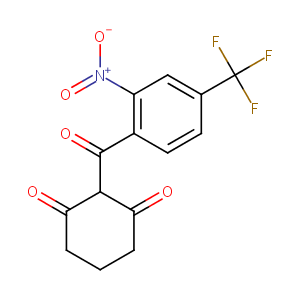Drug Information
| Drug General Information | Top | |||
|---|---|---|---|---|
| Drug ID |
D0V1UW
|
|||
| Former ID |
DAP000774
|
|||
| Drug Name |
Nitisinone
|
|||
| Synonyms |
Nitisinona; Nitisinonum; Nitisone; Orfadin; Nitisinone [INN]; SC 0735; FE-0200; Nitisinone (NTBC); Nitisinone [USAN:INN]; Orfadin (TN); Nitisinone (JAN/USAN/INN); 2-(2-Nitro-4-trifluoromethylbenzoyl)cyclohexane-1,3-dione; 2-(2-nitro-4-trifluoromethylbenzoyl)-1,3-cyclohexanedione; 2-(Alpha,alpha,alpha-trifluoro-2-nitro-p-tuluoyl)-1,3-cyclohexanedione; 2-[2-nitro-4-(trifluoromethyl)benzoyl]cyclohexane-1,3-dione; 2-{[2-nitro-4-(trifluoromethyl)phenyl]carbonyl}cyclohexane-1,3-dione
Click to Show/Hide
|
|||
| Drug Type |
Small molecular drug
|
|||
| Indication | Hereditary tyrosinemia type 1 [ICD-11: 5C50.11; ICD-9: 270.2] | Approved | [1], [2] | |
| Therapeutic Class |
Anticancer Agents
|
|||
| Structure |
 |
Download2D MOL |
||
| Formula |
C14H10F3NO5
|
|||
| Canonical SMILES |
C1CC(=O)C(C(=O)C1)C(=O)C2=C(C=C(C=C2)C(F)(F)F)[N+](=O)[O-]
|
|||
| InChI |
1S/C14H10F3NO5/c15-14(16,17)7-4-5-8(9(6-7)18(22)23)13(21)12-10(19)2-1-3-11(12)20/h4-6,12H,1-3H2
|
|||
| InChIKey |
OUBCNLGXQFSTLU-UHFFFAOYSA-N
|
|||
| CAS Number |
CAS 104206-65-7
|
|||
| PubChem Compound ID | ||||
| PubChem Substance ID |
10236750, 14753104, 29296848, 46507380, 47206901, 49957875, 50139362, 56311852, 57339133, 76271421, 93167147, 102979918, 103425313, 103987675, 104398189, 123051096, 124758249, 124896666, 125432673, 126666671, 128861885, 131293388, 134223796, 134338059, 135072534, 136340345, 137003783, 140881929, 143500522, 152030782, 152134009, 152227462, 152248599, 152344367, 160821612, 160963695, 162011463, 162165008, 162203592, 163091628, 163372627, 163775323, 164045265, 164175197, 164216726, 164763350, 165702339, 174007248, 174525942, 175268251
|
|||
| ChEBI ID |
CHEBI:50378
|
|||
| ADReCS Drug ID | BADD_D01572 | |||
| SuperDrug ATC ID |
A16AX04
|
|||
| SuperDrug CAS ID |
cas=104206657
|
|||
| Interaction between the Drug and Microbe | Top | |||
|---|---|---|---|---|
| The Metabolism of Drug Affected by Studied Microbe(s) | ||||
| The Order in the Taxonomic Hierarchy of the following Microbe(s): Gut microbiota | ||||
| Studied Microbe: Gut microbiota unspecific | [3] | |||
| Experimental Method | High-throughput screening | |||
| Description | Nitisinone can be metabolized by gut microbiota. | |||
| Target and Pathway | Top | |||
|---|---|---|---|---|
| Target(s) | Hydroxyphenylpyruvate dioxygenase (HPD) | Target Info | Inhibitor | [4], [5] |
| KEGG Pathway | Ubiquinone and other terpenoid-quinone biosynthesis | |||
| Tyrosine metabolism | ||||
| Phenylalanine metabolism | ||||
| Metabolic pathways | ||||
| References | Top | |||
|---|---|---|---|---|
| REF 1 | URL: http://www.guidetopharmacology.org Nucleic Acids Res. 2015 Oct 12. pii: gkv1037. The IUPHAR/BPS Guide to PHARMACOLOGY in 2016: towards curated quantitative interactions between 1300 protein targets and 6000 ligands. (Ligand id: 6834). | |||
| REF 2 | FDA Approved Drug Products from FDA Official Website. 2009. Application Number: (NDA) 021232. | |||
| REF 3 | Personalized Mapping of Drug Metabolism by the Human Gut Microbiome. Cell. 2020 Jun 25;181(7):1661-1679.e22. | |||
| REF 4 | Experience of nitisinone for the pharmacological treatment of hereditary tyrosinaemia type 1. Expert Opin Pharmacother. 2008 May;9(7):1229-36. | |||
| REF 5 | 4-Hydroxyphenylpyruvate dioxygenase as a drug discovery target. Drug News Perspect. 2003 Oct;16(8):493-6. | |||
If You Find Any Error in Data or Bug in Web Service, Please Kindly Report It to Dr. Zhou and Dr. Zhang.

